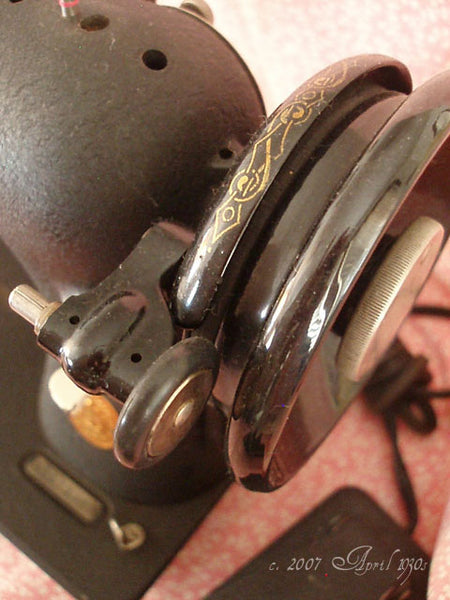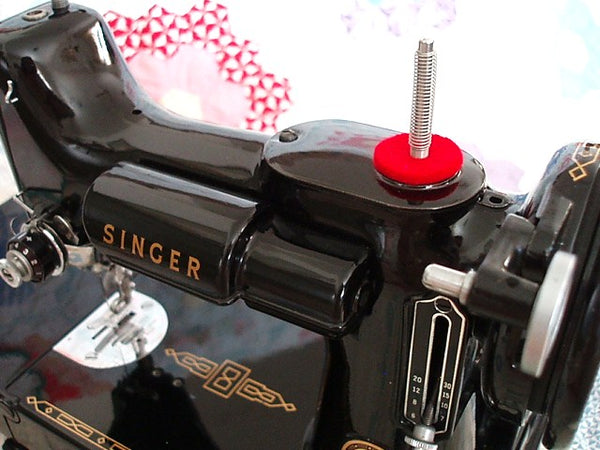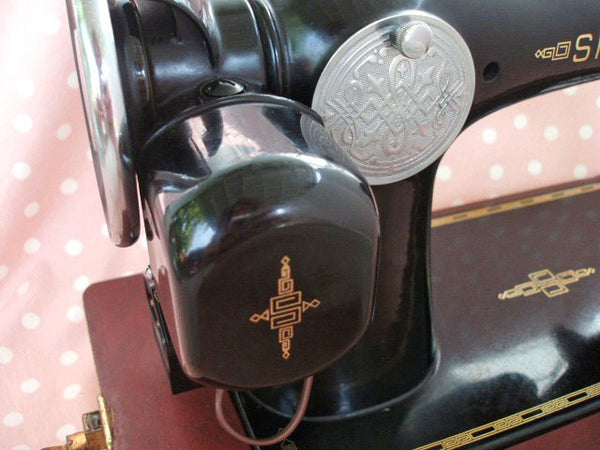How Does The Featherweight Compare to Other Singer Machines?

When Singer introduced the Featherweight in 1933 it was vastly different from most all sewing machines on the market. This article will compare the Featherweight to the other common Singer machines of its era.
First, to be considered an actual Singer "Featherweight", the sewing machine must be a 221 or 222 model (more information about subsequent number or letter suffixes here), and to learn about the differences of a 221 compared to 222 model, click here. So, while there were millions and millions of black sewing machine models made by Singer, the 221 and 222 models are the only ones that are considered to be in the Featherweight classification. As such, there are a few distinguishing characteristics that can be quickly ascertained when spotting a bona fide Singer Featherweight compared to other old, black Singers. If the opportunity allows for physically lifting a Featherweight 221 or 222 model, one can immediately note how lightweight it is -- just over 11 pounds. Contrast that with other Singer models which are made of cast steel, extremely heavy, and weigh nearly three times that! Seeing a machine in pictures, however, does not permit tangible evidence, so we will illustrate the most notable characteristics in photos, particularly when compared to other, more common vintage black Singer model machines.
In the article below, you will find the Singer Featherweight 221 model distinctions compared to a Singer Model 66, 15, 201, 99, and 301. There are many other models, of course, but these will help with knowing a Featherweight model and classification from any and all others. To determine what model a machine actually is, the serial number will be the easiest way to classify it. There were some errors and anomalies in the old, original Singer chart records, but they are still a helpful resource.
- Locate the machine's serial number - typically a letter or two followed by a series of numbers.
- Featherweight serial numbers and their date charts specifically are here.
- For all other Singer models click here, reading through the column headings of each chart for the model reference.
There are many, many unique parts to the Featherweight, of course, but the basic characteristics we noted and photographed on this page are to be referenced as a quick comparison guide.
FEATHERWEIGHT CHARACTERISTICS
A QUICK REFERENCE GUIDE
- Cast Aluminum, Lightweight at 11 lbs
- Flip-Up Bed Extension
- Motor Style & Placement
- Bobbin Case Access
- Light Fixture & Housing
- Bobbin Winder
- Compact Carrying Case
The Flip-Up Bed Extension
A Featherweight always has a hinged bed that folds up for access to the bobbin case.
The Motor
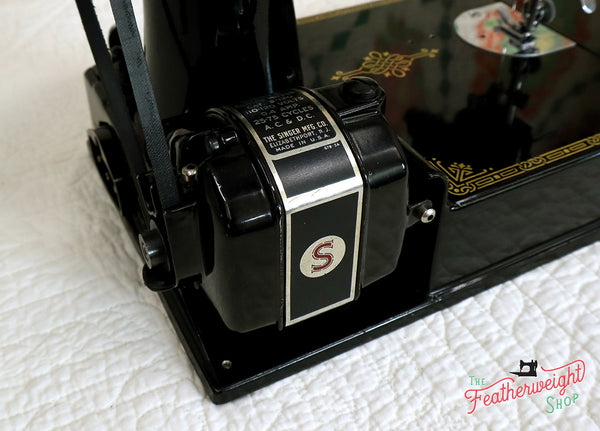
The motor sits low and in the back corner of the machine, distinctive in shape. Motors are not interchangeable with other models.
The Bobbin Case
The bobbin case is accessed on the left side of the machine, only when the bed extension is in the upright position.
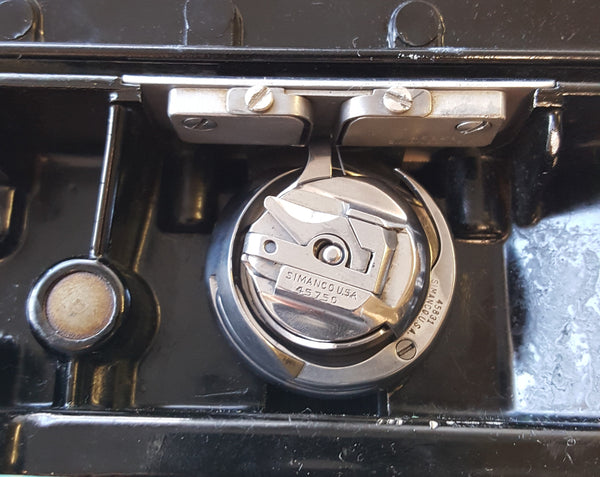
Distinct Front Light Fixture
The Featherweight light housing had two switch options (one on the base of the machine or one on the lampshade), but the shape and style were generally the same with placement on the front. The Featherweight light was a standard component of the machine.
Compact Carrying Case

In the photo above, you will see the typical appearance of the Featherweight case and its size comparison to the machine it carries. For a comprehensive case history, review the Historical Timeline here as well as the designated Case History article here.
Low Shank Attachments
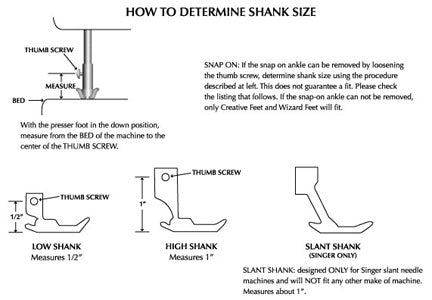
All Featherweights take a low shank presser foot as well as low shank attachments. (Click here for the chart showing all the Singer Attachments that are compatible with the Singer Featherweight.) Having a low shank is not a distinctive characteristic to the Featherweight, because many vintage Singer machines take low shank attachments. However, we wanted to make mention of it for the comparison to some later model Singer machines, namely the Singer 301 further down this page.
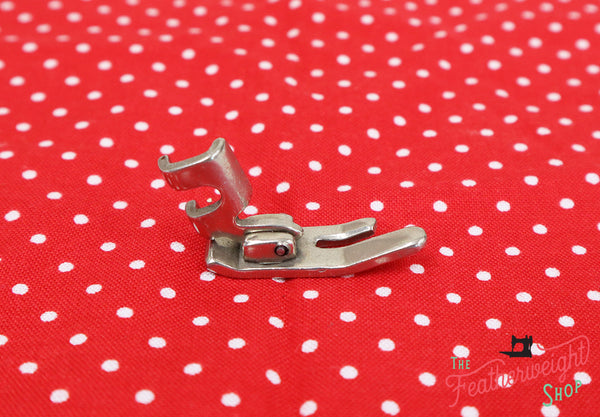
A low shank presser foot, same as one that is used on a Singer Featherweight.
The Singer Model 66 and the Featherweight 221
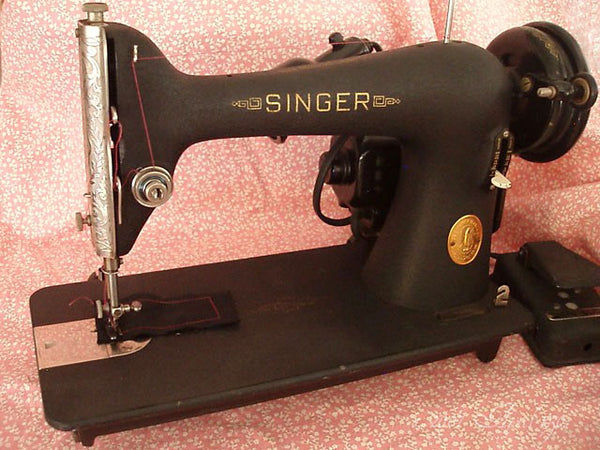

What is different about the 66?
- Weight: 28lbs
- The 66 model does not have a flip-up bed
- Bobbin Winder with Rubber Tire
- Light fixture placement and style
The bobbin winder displayed above has a rubber tire pressing against the metal handwheel compared to the wheel of the Featherweight bobbin winder pressing against the rubber belt.
The bobbin winder wheel on a Singer Featherweight (available in several styles) is pushed against the rubber belt when winding bobbins. The belt's rotation causes the bobbin winder wheel to rotate to then turn the bobbin freely as it fills with thread.
- The 66 model Singer has a top-loading bobbin, accessed directly from the top on the bed of the machine. A top slide plate is slid over to the left revealing access to the bobbin.
Top-loading 66 class bobbin (the 201 takes the same bobbin as the 66) shown above contrasts the end-loading bobbin/case on the Featherweight shown below.
Class 66 Bobbins:

A Singer 66 Model takes class 66 Bobbins which are taller, compared to a Featherweight bobbin, and have a very slight curve on each end.
The removable light housing on a Singer 66 (shown above) is considerably larger and, if present, placement was on the back of the machine. Whereas, on a Singer Featherweight, the permanent light fixture is compact and placement is always on the front.
The Singer Model 15 and the Featherweight

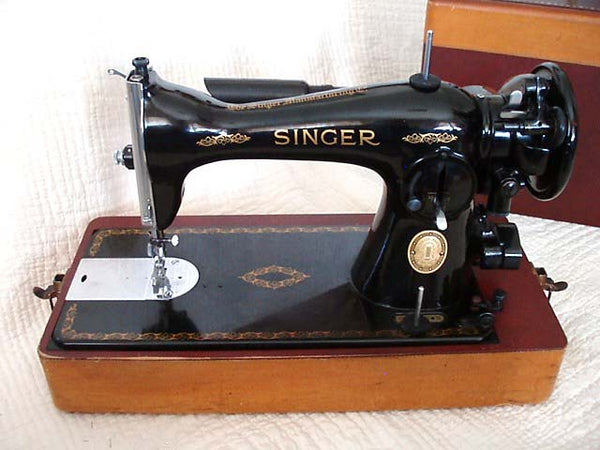
What is different about the 15?
- Weight: 27lbs
- Model 15 has no flip-up bed
- Rubber Bobbin Winder Tire
- Bobbin Access
- Motor Style
- Tension Unit Placement
- Light fixture is on the back of the machine
The bobbin winder displayed above has a rubber tire pressing against the metal handwheel compared to the wheel of the Featherweight bobbin winder pressing against the rubber belt.
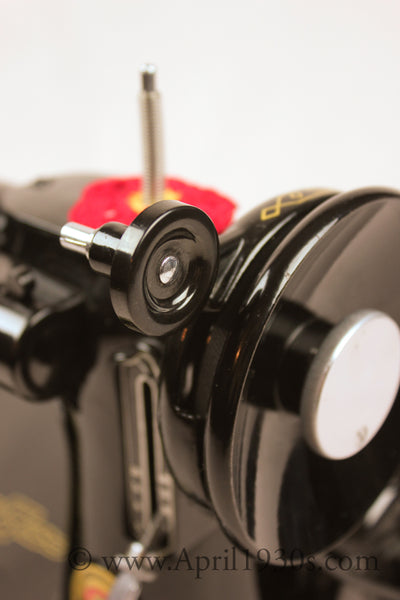
- Singer 15 Model uses a 15 Class Bobbin



- Motor Style

The photo above shows the Singer 15 motor geared directly into the machine, and the photo below shows a photo of a Featherweight motor connected to the machine with a bracket and driven by the external Featherweight-specific V-belt.
- Tension Unit Style & Placement
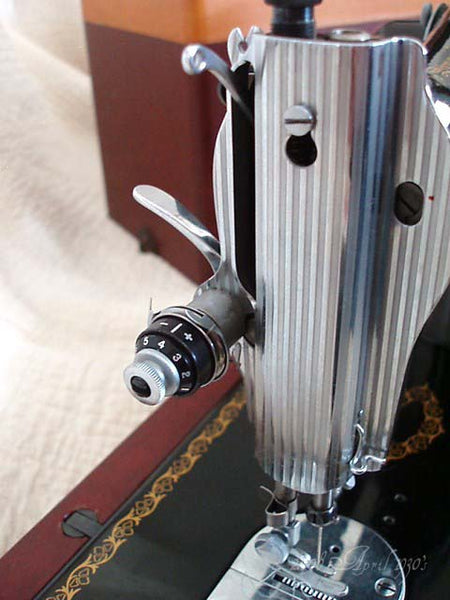
The photo above shows the tension unit on the end of the Singer 15 model machine compared to the Featherweight tension unit on the front of the machine shown below.

- Light Fixture Style & Placement
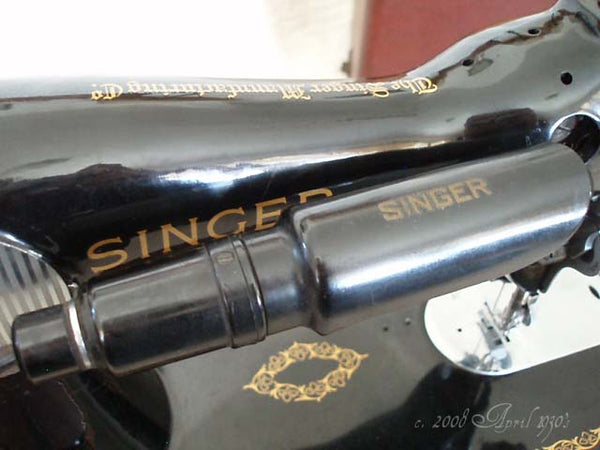
The light fixture on a Singer 15 (shown above) is considerably larger and the placement is on the back of the machine. Whereas, on a Singer Featherweight, the light fixture and housing is compact and placement is always on the front.
The Singer 201 Model and the Featherweight
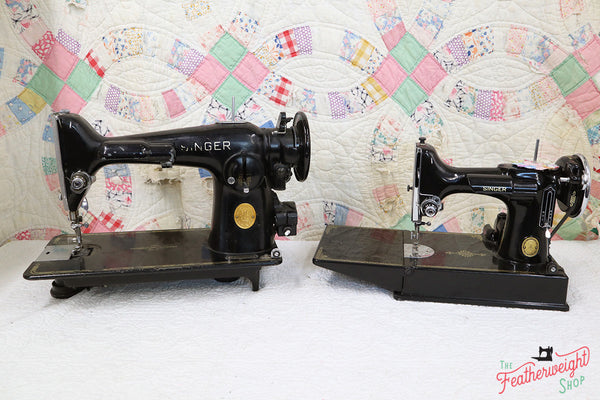
What is different about the 201
- Weight: 32lbs
- The Model 201 has no flip-up bed
- Treadle Drive on the 201-1
- Rubber Bobbin Winder Tire
- Bobbin Access
- Light housing style and placement

- The Singer 201 takes the 66 class top-loading bobbin

- Motor Placement & Style
The 201 Model's "pot motor" shown above is geared directly into the machine, and the photo below shows a photo of a Featherweight motor connected to the machine with a bracket and driven by the external Featherweight-specific V-belt. 
- Hook Assembly / Drop-In Bobbin Style
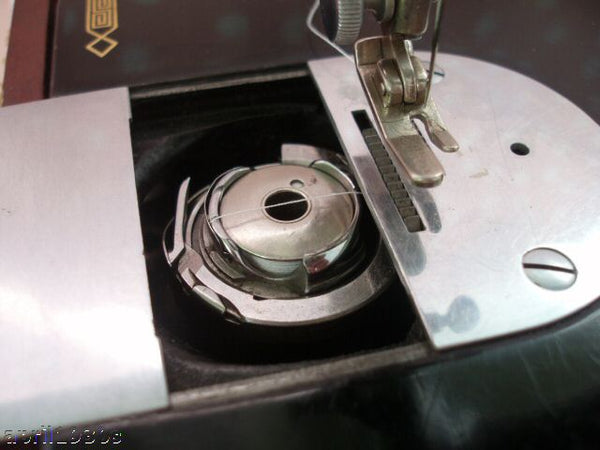
The 201 model Singer has a top-loading class 66 bobbin (the 201 model takes the same bobbin as the 66), accessed directly from the top on the bed of the machine. A top slide plate is slid over to the left revealing access to the bobbin.
This contrasts the end-loading bobbin/case on the Featherweight shown below.
- Light Housing Placement and Style
The light housing on a Singer 201 (shown above) is different in shape and the placement is on the front left of the machine. Whereas, on a Singer Featherweight, the light housing is compact and placement is always on the center front.
The Singer Model 99 and the Featherweight
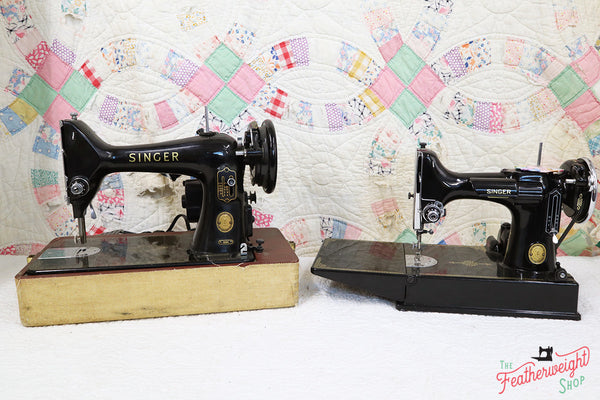
What is different about the 99?
- Weight: 22lbs
- Model 99 has no flip-up bed
- Uses 66 Class Bobbins
- Bobbin Winder Rubber Tire
- Bobbin Access
- Light housing placement and style

- Rubber Bobbin Winder Tire


- Top-loading 66 class bobbin
Top-loading 66 class bobbin (the 99 takes the same bobbin as the 66) shown above contrasts the end-loading bobbin/case on the Featherweight shown below.
- Light Housing Placement and Style
The light housing on a Singer 99 could vary in shape and style, but the placement was always at the back of the machine. The one shown above is considerably longer in shape compared to a Singer Featherweight's light fixture, which has its standard compact style, and placement is always on the center front of the machine.
The Featherweight and the 301
The Featherweight and the 301 are very different, yet very similar. They are both made of cast aluminum making them relatively lightweight, and they both have flip-up extension beds. They use the same bobbin case as well as bobbins and the same style hook assembly. (The hook assembly is not precisely the same as most Featherweights, so this portion can be a little bit tricky; stay tuned for a future blog post on this topic.) The tension unit is also the same.
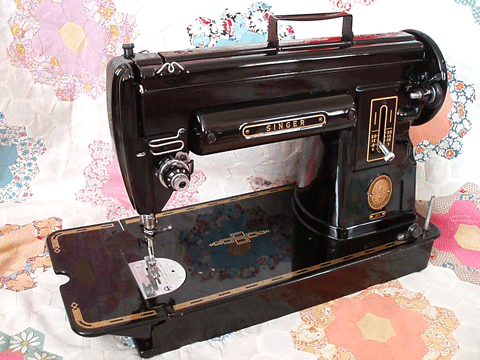

-
Shape & Weight: Boxier shape & weighs about 16 lbs
The black 301 is shown here, but it was also available in a mocha solid color as well as a mocha / cream two-tone color scheme. The black 301 is more Art Deco in its appearance. - Rubber Bobbin Winder Tire
- Motor not visible

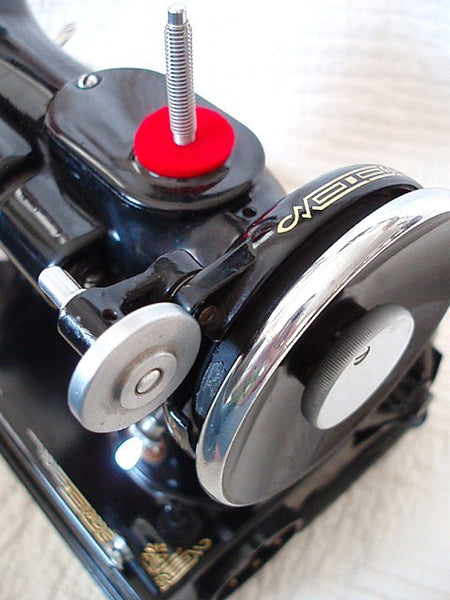
- Slant Shank

All 301 machines have a slanted shank. The presser foot and all attachments are taller, angled and not interchangeable with the Featherweight.
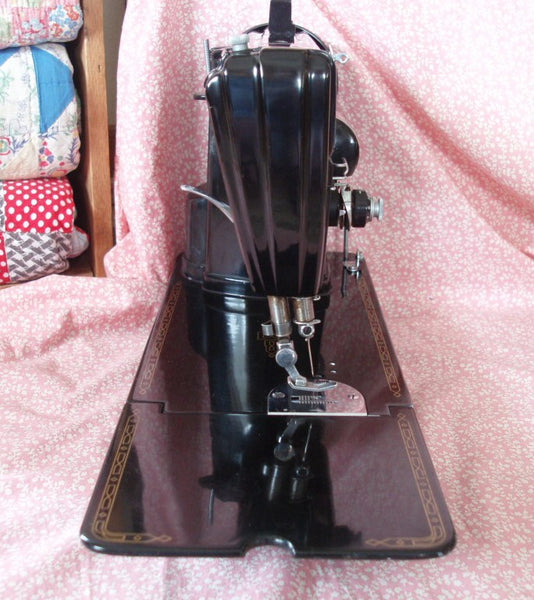
Note the angle of the presser bar and needle bar on the 301 in the photo above compared to the photo of the Featherweight below.

The presser bar on the Featherweight is vertical, straight up and down, and the presser foot is shorter than the 301 presser foot. Low shank attachments have also been called short shank attachments.
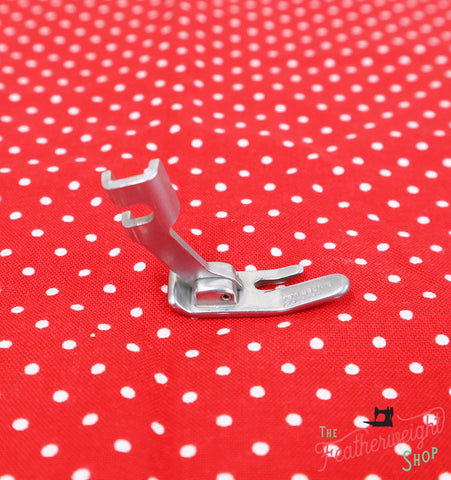
Singer 301 SLANT SHANK Presser Foot will not fit on a Singer Featherweight.
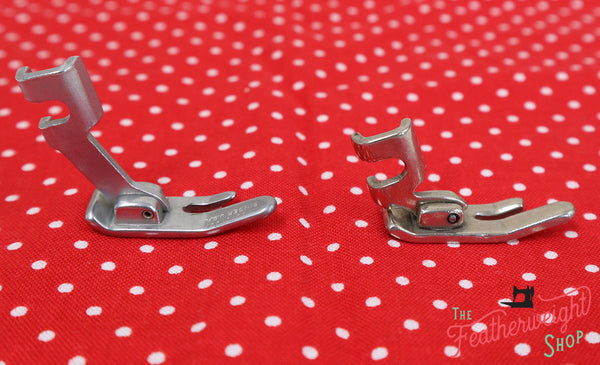
- The Motor Style & Placement
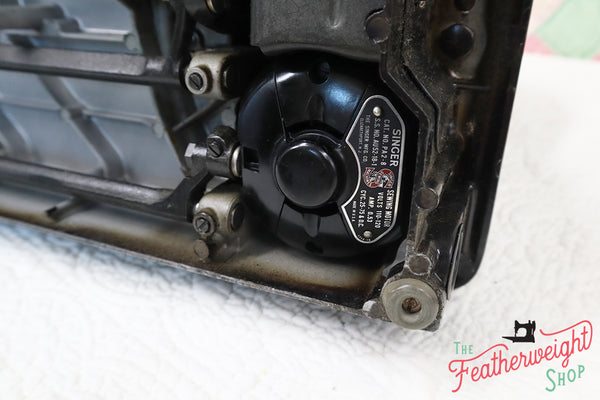
The photo above shows the Singer 301 motor underneath the machine with the drip pan removed. It is geared directly into the machine, and the photo below shows a Featherweight motor connected to the machine with a bracket and driven by the external Featherweight-specific V-belt.

As the Featherweight has grown in popularity over the years, the term "Featherweight" has been used loosely to title many old black Singer model machines. We hope that the information and photos in this article will serve as a quick guide for identification and classification of an actual Singer Featherweight. The other Singer models are indeed wonderful machines, but they are not Featherweights. That being said, knowing the characteristics of the Featherweight by comparison can help with correct nomenclature as well spotting the real deal at yard sales, flea markets, thrift stores, antique stores, or even on the online selling markets. Happy Featherweight hunting!




